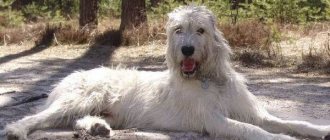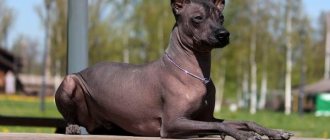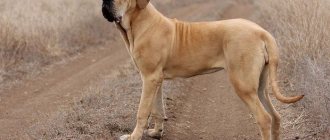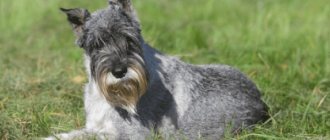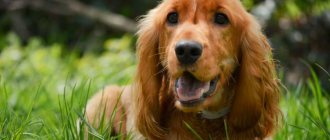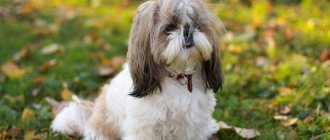Description of the Basenji breed
Popularity 160th place among 263 dog breeds
Lifespan:
12-16 years old
Height:
males: 43 cm, females: 40 cm
Country of origin:
Central Africa
Average price:
20-30 thousand rubles
Weight:
males: 11 kg, females: 9.5 kg
Latest articles Cat health
Rabies vaccination for cats: choice of vaccine, necessity, schedule 01/22/2022 4 0 0
Selection and adaptation
TOP 20 best cat breeds for families with children 01/22/2022 25 0 0
Breed traits
Breed traits (on a 5-point scale)
| Basenji | |||
| Activity | in the house | 3.7 | |
| on the street | 4.4 | ||
| Obedience | training | 2.7 | |
| strangers | 3.6 | ||
| Domination | in family | 3.2 | |
| over dogs | 3.5 | ||
| Defending your territory | from people | 2.7 | |
| from dogs | 3.3 | ||
| Sociability | in family | 4.3 | |
| with strangers | 2.6 | ||
| with dogs | 3.4 | ||
| Concentration | in family | 2.3 | |
| in front of strangers | 3.3 | ||
| with dogs | 2.4 | ||
| Aggressiveness | in family | 1.9 | |
| to strangers | 2.6 | ||
| to the dogs | 3.3 | ||
| to cats | 3.3 | ||
| Family behavior | calmness | 2.6 | |
| demand for affection | 3.7 | ||
| excitability | 3.4 | ||
| playfulness | 4.1 | ||
| excessive barking | 2 | ||
| behavioral breakdowns | 3.7 | ||
| Tolerance for children | up to 4 years | 2.6 | |
| over 4 years old | 3 | ||
| Institutional use | watchman | 3 | |
| bodyguard | 2.6 | ||
This breed is often compared to the following dog breeds: Jack Russell Terrier, Shiba Inu (Shiba Inu), Beagle, Miniature Pinscher (Miniature Pinscher), Cardigan Welsh Corgi.
Key facts
The Basenji is one of the most ancient dog breeds and is an excellent hunter. There are many other animal names related to their characteristics or country of origin: African non-barking dog, Zande dog, Congo forest dog, Congo terrier, Nyam Nyam terrier, Congolese bush dog.
Individuals of this breed appeared on the territory of the African continent, without human intervention. The bush dog is entirely the result of natural selection. The description of the Basenji breed emphasizes this fact.
The main distinguishing feature of Basenjis is that they hardly bark. Their communication with relatives or people occurs through snorting, purring, sighing or sounds reminiscent of quiet laughter. The characteristics of the Basenji breed highlight this as a significant advantage.
There is a legend that explains this. It says that the leader of the Basenji pack learned a very important secret. Not wanting to give her away, he and his relatives swore an oath to remain silent forever.
The Congo Terrier is classified as a medium-sized breed. Males grow up to 43 cm, the height at the withers of a female reaches 40 cm. The weight of a male Basenji is about 11 kg, females – 9.5 kg. The life expectancy of the Basenji reaches 12-16 years.
The external features of the pet include its wrinkled forehead and a strong, curled tail. It should be noted that the four-legged friend does not smell. There is no need to wash representatives of this breed, especially since they are genetically afraid of water. They manage hygiene on their own, washing like a cat.
General characteristics of the Basenji
Some dog breeders believe that the Basenji dog is ideal for keeping in an apartment. It is suitable for active people for whom silence and cleanliness in the house are important. These pets do not bark and do not smell like dogs. But in addition to calm behavior and ease of care, the Basenji has disadvantages. This is an ancient hunter, smart, independent and self-reliant. Sometimes dog handlers say that it is the Basenji who accepts a person into his pack, and not the person who gets a pet.
This breed is not suitable for inexperienced owners, as well as for those who need an obedient pet dog. Basenjis were not artificially bred, so they retained their ancient instincts and behavioral characteristics. Those who are captivated by the lack of barking and easy grooming may encounter other problems in keeping or training. The uniqueness of this dog is that the Basenji's bark is very high-pitched. It is easy to teach her to sing, she can grumble and make sounds similar to laughter. Many owners consider this a great advantage and teach their pets to “talk.” Several videos show the Basenji talking and singing:
Video: How a Basenji barks or the “Voice” command
Video: Basenji sings
Video: Talking Basenji
| Options | Characteristics |
| country of origin | Central Africa |
| group of breeds according to the ICF classification | Spitz |
| life expectancy | 13-16 years old |
| height | females 39-40 cm, males 41-43 cm |
| weight | females 9.5 kg, males 10-11 kg |
| aggressiveness | not aggressive, friendly |
| activity | average |
| need for care | low |
| training | complex |
pros
When the world learned about this breed, it became popular. For those who manage to properly raise a Basenji, he becomes a loyal friend, a devoted and intelligent companion. Representatives of the breed have many advantages:
- small size allows you to keep it in a small apartment;
- look beautiful;
- at home they behave very quietly and calmly;
- smart, quick-witted;
- not aggressive, treat people kindly;
- very clean, lick themselves like cats, do not require frequent bathing;
- there is no dog smell from the fur;
- easy care, almost no shedding, no allergies;
- well-developed hunting and guard qualities;
- hardly bark;
- healthy, with good care they live up to 16 years.
Minuses
But this breed is not easy to keep. Basenjis also have many disadvantages:
- very active, energetic, need high physical activity;
- inquisitive, often play pranks and misbehave;
- independent, stubborn, do not like to obey;
- they steal food, pick it up on the street;
- can run away, as the hunting instinct makes them chase everything that moves;
- do not get along well with pets and can be aggressive with other dogs;
- cannot tolerate cold or water; clothing is needed in damp and cold weather;
- are still quite rare, so purebred puppies are expensive.
Video about the pros and cons of the breed:
Video: Basenji: The Non-Barking Dog Not for the weak
Features of the Basenji breed
The popularity of this breed is explained by its unique qualities that cannot be found in other dogs. The following unusual characteristics can be noted:
- You can hardly hear barking from the Basenji, instead you hear rumbling, grumbling, snorting, grunting or howling;
- the special structure of the larynx allows them to produce sounds similar to Tyrolean yodel tunes;
- when the dog is interested in something, it rises on its hind legs and can stand for a long time;
- representatives of the breed do not like water, wash themselves, and are very clean;
- have cat-like habits, can climb trees, and can climb onto a table or cabinet at home;
- the developed hunting instinct cannot be brought under control, even professional training does not help - the Basenji will still run away if something attracts it;
- Research by scientists has determined that this dog is a genetic subspecies of the gray wolf;
- Dog experts consider the Basenji to be the smartest dog of all breeds, but the most difficult to train.
History of the Origin of the Basenji
Scientists consider the Congo Terrier to be the oldest breed of dog existing on earth. They appeared over 6 thousand years ago. Archaeologists have found numerous figurines in the shape of this animal and their images. Richly decorated Basenji mummies have been found in ancient burial grounds.
The birthplace of the non-barking pet is called Central Africa. The tribes of Sudan, Congo and Liberia often used dogs as hunters. The natives called this breed “jumping up and down” because of its excessive activity and jumping ability.
In addition to their country of origin, the Basenji has become widespread in other places. Pets were treated with special reverence and were given as a sign of respect. At that time, the dog protected its owner from witchcraft and evil forces. Representatives of the Congo Terrier were highly valued in Ancient Egypt before the decline of civilization.
In 1895, the rest of the world first became acquainted with these unusual animals. The first individuals did not survive the long journey, but dog breeders were very interested in stories about them. In 1937 in England at the Kraft exhibition there was an official presentation of this breed. On the American continent we met a forest dog from the Congo the following year.
After World War II, the Basenji became widespread due to its success at international exhibitions. Not a single prestigious show was complete without the demonstration of African animals.
Representatives of royal families around the world did not ignore them either. The Congo Terrier was the pet of the King of Egypt Farouk, Queen Julia of the Netherlands, and the Princesses of Monaco.
In our country, breeding of these animals began in 1977. But Basenjis are still not very common in Russia.
Nowadays, they are more often used as companions rather than hunting dogs.
How to buy a Basenji puppy
It is difficult to find a purebred Basenji puppy, since dogs are rare in our country. If you decide to get such a pet, you need to contact a good nursery. You can buy a dog inexpensively at the market or secondhand, but it is unlikely to be a purebred dog. The price of a real Basenji in Moscow starts from 30 thousand rubles. A puppy with deviations from the standard can be bought for 15-20 thousand. He will have a pedigree, but he will not be allowed to show or breed.
Puppies of this breed are for sale from 2 months. The only characteristic of the breed at this age can be the standard color and specific wrinkles on the forehead. The puppy must be well-fed, cheerful, and clean. The coat is smooth, shiny, eyes and ears are free of discharge. It is important to pay attention to the living conditions of the animals and the behavior of the parents. The photo shows what Basenji puppies should look like:
Basenji puppies
Basenji puppies
Interesting video about Basenji dogs and its features:
Video: All about Basenji dogs
The non-barking Basenji dog is a unique and difficult pet to keep. Suitable for an active, strong-willed person who can pay enough attention to her. With a beautiful appearance, proud bearing and independent character, this dog can become a faithful companion, but it will require patience and perseverance. She will not listen to a weak, insecure person.
Basenji appearance
General impression
Representatives of this breed look very advantageous compared to some stockier hunting dogs. The proportions of the animal are harmonious, well balanced by nature itself. In general, the exterior of the individual amazes with its proud appearance and royal posture, and this can be seen even from the photo of the Basenji.
Head
The length of the skull is slightly longer than the length of the muzzle. The head is beautifully defined, rather flat, of medium width. The cheekbones taper closer to the nose. The breed standard implies the presence of folds and wrinkles on the forehead, clearly expressed during alertness.
The obliquely set eyes are almond-shaped and dark in color. They express all the intelligence and intelligence of the animal.
The Basenji's small ears have sharp tips at the end. They are set high and have a slight forward slope. The nose is medium in size, usually black.
Neck
The neck of animals should not be thick, but rather long and muscular. It widens slightly towards the base and looks graceful thanks to its beautiful curve.
Torso
The body is well balanced. The chest is wide, oval in shape with protruding ribs. It smoothly blends into the toned lower line of the body.
Forelegs
The front legs of the Congo Terrier are thin, but very strong with long forearms. Elbows point back. The pasterns are straight and flexible with padded pads.
Hind limbs
They are distinguished by strong bones and well-developed muscles. The shins are of sufficient length. The hock joints are parallel but strongly let down.
Tail
It is set quite high and twisted into a ring of one or two turns. The tight tail lies on the pet's rump. The gluteal muscles protrude beyond the base of the tail, giving the appearance of being overdeveloped.
Movement
The dog can move quickly, jumping over obstacles and developing a fairly decent speed. The pet's long limbs help it not to get stuck in sand or mud.
Wool
The Congo Terrier's coat lies tightly to the body. The hair is short and shiny. The wool is quite soft and thin to the touch.
Color
Representatives of the African breed are black and white with melon seed tan, red and white or brown and white. In 2000, the color brindle with distinct black stripes was recognized. With any Basenji color, white must be present on the paws, tip of the tail and chest.
Size
Ideal indicators for females are height 40 cm, weight 9.5 kg. Males weighing 11 kg and height at the withers 43 cm are considered standard according to the Basenji size chart.
The height of the Basenji allows them to be classified as a medium-sized dog breed.
Basenji character
As members of the hunting breed, bush dogs are always ready to run somewhere. Irrepressible energy and increased activity are character traits of the Basenji.
They are also characterized by loyalty and devotion to the owner. But inducing such an attitude in a four-legged animal is not entirely easy. He must watch the person and get used to it. The dog will be wary of strangers, but will not be the first to show aggression.
Since no one took part in the selection of the breed, the ability to adapt to different conditions, natural intelligence, intelligence and independence are the result of natural selection.
Reviews from owners clearly indicate a certain self-confidence in their pets, which can cause difficulties in raising them.
At home, the owner and his family members will fully experience the devotion and love of the Basenji. He will get along well with dogs. But other animals - cats, hamsters or birds - will not be able to count on the favor of the Congo Terrier.
These proud pets hardly tolerate the pranks of children living with them in the same apartment or house. But they make excellent guards.
Dogs are great for living in high-rise buildings. Due to the inability to bark, Basenjis express their feelings and emotions by purring. This is very convenient for owners of city apartments.
By showing love and patience, the owner of a Congo Terrier will receive a pet that will be devoted to him for many years.
Breed characteristics and character
The Basenji is a unique dog breed with a centuries-old history. It appeared more than 4000 years ago in African countries and was an indispensable assistant in hunting. The non-barking Basenji dog was even mentioned in ancient Egyptian myths and was of great value to the people of that time as a loyal friend and companion.
Due to the fact that the Basenji breed was not artificially bred, it has retained hunting instincts and practically does not accept training. But the African silent bird carries out simple commands necessary for everyday life without problems.
For the most part, the success of training depends on the relationship between the owner and the dog. If you establish contact with your dog, then throughout its life it will be interested in acquiring new knowledge.
But you should not punish a puppy for refusing to train, otherwise in the future she will simply refuse altogether. More often it is worth switching her attention to games and giving her a rest between classes.
The main feature of this dog is the absence of barking, typical of other breeds. This does not mean that she does not bark at all, but the Basenji's bark has a higher pitch due to the different structure of the larynx.
The African silent dog is an extremely clean dog that washes itself with its paws like a cat and brings virtually no smell into the house. And also some owners of their reviews characterize the Basenji as a hypoallergenic breed, but each dog is individual and this should be taken into account when buying a puppy.
This dog has a very cheerful and playful character, which is not suitable for sedentary people. The dog does not accept training, but willingly engages in small hunting due to its remaining hunting instincts.
They will be a faithful friend for many years, as they become strongly attached to their owner and will diligently protect him from unfamiliar people. They are not aggressive towards children and enjoy playing outdoor games with both adults and children.
Education and training
Some breeders and trainers consider this breed difficult to train. They explain this by the independence of the formation of the mentality of animals without human participation. Indeed, Basenjis do not immediately concentrate on fulfilling the owner’s demands and are very reluctant to carry out commands.
However, this behavior does not indicate the natural stupidity of Congo Terriers. It’s just that in the conditions of evolution they are accustomed to obeying instinct, and also getting out of difficulties without human intervention. Only by showing sufficient patience and love, taking into account the characteristics of the breed, will the owner be able to achieve excellent results in raising and training the Basenji.
At the beginning of training, it is important to pay a lot of attention to teaching the puppy to call. The kid is sure that he knows where to walk, what to pick up or who to chase. To get rid of his excessive independence and self-confidence, it is best to use a roulette leash while walking. Until your pet learns the command “Come to me!”, you should not let him off the leash.
Sensing freedom, the dog will rush to chase a cat or another dog, but a person cannot catch it. The pet should be interested in being near its owner, so it is recommended to play with it during a walk and treat it with a treat. By adjusting the tension of the tape measure, they perform exercises to practice the command.
In a master-dog alliance, it is important to understand who is in charge. Only by recognizing a person as a leader will the Basenji begin to respond better to demands and orders.
When raising such a self-confident breed, it is necessary to take into account a number of principles:
- be fair and generous in praise for a correctly executed command;
- practice skills regularly, regardless of circumstances;
- show maximum patience and understanding;
- do not use physical punishment;
- combine individual training with group work.
A well-bred Basenji understands who is boss in the house. If he is on the owner's path, he must let him through. The pet is obliged to give food out of its mouth at the first request of the owner. This skill needs to be practiced because of his love of picking up everything on the street.
You should not let your pet get bored; you need to exercise or play with him. Otherwise, domestic pogroms, chewed furniture or shoes are not uncommon. The reason for such pranks is most often loneliness and boredom.
Looking for a Basenji? Find your pet from 2 offers As a gift
Basenji Health and Diseases
Possible diseases
On average, dogs live from 12 to 16 years. The health of the Basenji is quite strong, but requires monitoring its condition and regular visits to the veterinary clinic. Only in this case will the pet delight the owner with its presence for a long time.
We should not forget about the animal’s love for eating various garbage picked up from the ground. This can cause serious poisoning. Therefore, the owner’s first aid kit should contain drugs that help save from serious consequences: potassium permanganate, Glauber’s salt, alomorphine for injection and magnesium oxide solution.
It is necessary to strictly adhere to the vaccination schedule, regularly carry out deworming, and treat with flea and tick repellents.
One of the most serious diseases among Congo Terriers is Fanconi syndrome. This is a kidney disease that manifests itself in impaired filtration function. The result of this disease is weight loss, muscle atrophy and severe dehydration. If the syndrome is not treated early, you may lose your dog. Symptoms include excessive thirst and frequent excessive urination of the pet.
Obesity, fever, swelling of the paws may be signs of another terrible disease. Hypothyroidism is a disorder of the thyroid gland. The disease has a good prognosis if timely treatment is started.
Adult Basenjis may exhibit hereditary retinal atrophy. Eating disorders and allergies are common. And due to high mobility, joint dislocations occur.
Reproductive health
The first heat in bitches occurs at one and a half years of age. Then you can start breeding dogs. It is best to carry it out in the male’s territory.
Sterilization of females is carried out after a year of life in the absence of inflammatory processes in the dog’s body.
Features of feeding and diet
It is impossible to maintain good health for your pet without a properly organized and balanced diet.
It is important to maintain a balance between tasty and healthy in your pet’s menu. It is worthwhile to diversify it from time to time. The diet should be based on protein. Meat products should be low-fat; cartilage and offal can be used. It is useful to include vegetables and fruits in the Basenji's menu. Fish is also healthy, but only sea fish and low-bone fish when boiled. Recommended cereals are rice, buckwheat and oatmeal. You need to give pearl barley with caution, as it clogs the intestines.
Dry food can be used, but it must be at least premium and contain all the necessary vitamins and mineral compounds.
The owner decides what to feed the pet, but feeding twice a day is considered the norm for an adult pet. The bowl should remain empty after feeding. We must not forget about clean water, which is necessary for proper digestion.
From the age of one month, puppies should be fed fermented milk products, cottage cheese, raw quail eggs, oatmeal with the addition of grated carrots. Such food guarantees the presence of useful elements in the baby’s diet.
It is not recommended for an animal of any age to give treats from the owner’s table. Basenjis are strictly prohibited:
- sweets and chocolate;
- flour;
- spicy or salty foods;
- fish and tubular bones.
You should not overfeed your pet. A slight feeling of hunger should always be present in a healthy individual to maintain its activity.
Care and maintenance
Some features characteristic of the Basenji allow them to be kept in a city apartment or in a country house.
Care and maintenance of the Basenji are simple, because the smooth coat does not require cutting or combing. At the same time, the animal does not leave behind a dog smell, even if the coat is wet. Puppy hair needs periodic brushing to remove loose bristles. An adult does not need this type of care.
The eyes and ears of Africans must be kept clean. The ears are cleaned of dirt at least once a week using a cotton swab and a special lotion. It is recommended to use boiled water to wipe and cleanse your pet's eyes. This procedure helps prevent the occurrence of inflammatory processes.
African dogs' nails are thick and usually wear down when walking on hard surfaces such as asphalt or rocks. If this is not enough, then use nail clippers and a file to do a dog manicure.
Basenjis are truly clean and wash themselves like cats. Dogs do not need washing due to their almost complete aversion to water. Most likely, such negativity is associated with memory at the genetic level. The fear of crocodiles that live in African waters has completely discouraged dogs from getting into the water. If necessary, you can wipe the stained area with a damp towel.
It is recommended to walk your pet 2-3 times a day. Walks in the fresh air should be active, accompanied by active games and exercises.
Tips for choosing a puppy
Only after studying all the features in the character of the Basenji, you need to make a decision about purchasing a puppy of this breed. In Russia, Congo Terriers are represented in rather small numbers, and buying a baby will not be an easy task.
It should be noted right away that it is unlikely that you will be able to buy a purebred animal at the poultry market. You need to make your choice in specialized nurseries. However, be prepared to pay a premium price for this rare specimen.
Experienced breeders will tell you how to choose your future pet. Thus, it is believed that the first acquaintance is best with a puppy who has reached the age of 8 weeks. Although it is customary to buy representatives of other breeds at the age of one and a half months.
When examined, a Basenji child should be strong, moderately well-fed, with a clean face and clean ears. It is necessary that its color matches the standard colors of the animal. It is worth paying attention to wrinkles and folds on the forehead. They are an integral feature of the breed.
Basenji behavior also requires initial observation. Attention should be paid to his communication with his mother and other babies. The friendliest puppy in the litter is considered the best choice. He is almost guaranteed to have a stable psyche, which will make his upbringing easier.
The parents of the future pet must be in good physical shape, properly raised and not show excessive aggression. Then the puppy will get good genetics.
When choosing a Congo Terrier, it would be a good idea to look at the conditions in which other Basenji puppies and their parents are kept, and also find out about their diet. A conscientious breeder will easily answer all questions and provide the necessary documents for the dog: a puppy card and a veterinary passport.
The latter should contain information about the first comprehensive vaccination and the results of the test for dysplasia. It’s a good idea to find out about the timing of the last deworming treatment.
Kennel Dog Aristocrat. Jack Russell Terrier, Basenji
Take the Attention Test! Find 10 differences! (click right here!)
Find the answer Are you bothered by some problem or question? Enter “Breed” or “Name of the problem” into the form, press Enter and you will find out everything about the issue that interests you.
| Description: | Jack Russell Terrier puppies for sale from award-winning parents of the Dog Aristocrat kennel, show class. 4 boys with RKF documents (metrics), smooth-haired, white-red and tricolor, brand, veterinary passport. Born 02/09/2016. Help in growing |
| Contacts: | 89262331055 |

